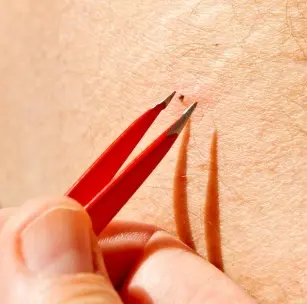
What is the natural habitat of ticks, where do they mainly live, what diseases, apart from Lyme disease, do they carry, does erythema always appear after a bite, how to safely remove a tick. What do we really know about ticks?, are they as dangerous as we think?, how to protect yourself against them and what should be done to avoid the unpleasant effects of a tick bite?. Until quite recently, we hardly heard about ticks at all, we did not worry about the next dangerous disease transmitted by them. More and more often, however, there is information about the increasing population of ticks and the infections they more and more often give to mushroom pickers, forest wanderers or even people spending a nice time in their own gardens.
Where ticks really live. It is a myth that ticks fall on our heads from trees or bushes. The head is too hard for them. Ticks live mainly in grass, forest litter, meadows, dense thickets, city parks and even lawns in our gardens. Ticks live 20 to 30 centimeters from the surface of the ground, therefore, once they reach our body, they wander from the feet up in search of a soft, warm and moist place. They especially like to screw themselves into the groin or skin folds. When a tick finds us, it does not react to any colors because it has no eyes. Instead, it has chelicerae that allow it to respond to our sweat, air movement and heat. This is the first and most important signal for the tick that the host, i.e. the human, is close. It is also not true that the tick attaches itself immediately. It needs some time. That is why it is very important that after returning from a forest trip or a meadow escapade or picnic, you thoroughly check your whole body and take a shower. Then we can be sure that nothing threatens us. There are also preparations on the market that are designed to scare away these little monsters. Their operation consists mainly in emanating an unpleasant smell for the tick.
Ticks are most active in in May and June and in September and October. They prefer morning existence from the first dew to noon, and then, after a few-hour break, they become active from 16 pm to dusk. The increase in the number of ticks was caused by the warming climate and mild winters, which allow ticks to survive this time in lethargy.
Ticks climb up to a maximum height of 150 centimeters, which is more or less the height of our waist or back of a larger animal. If we find a feeding tick on ourselves, we must safely remove it. Special tick removal pumps or tick traps are available in pharmacies. But what to do if we are not so professionally prepared and we need to quickly get rid of the uninvited guest. Removing a tick is neither pleasant nor easy if it is done for the first time. Accuracy counts, use tweezers and grab the tick as close to the body as possible and pull it out quickly and decisively.
You must not lubricate the tick with anything or clumsily pull it out, as this may lead to the tick vomiting and faster introduction of bacteria and viruses into our body. After removing the tick, wash the area with 40 percent alcohol and watch closely. In most cases, nothing disturbing happens, but sometimes there is erythema, which is one of the first signs of infection by tick with borreliosis.
The erythema is red in color, warm but painless. It is then necessary to visit a doctor and treat Lyme disease with antibiotics. Infection with this disease occurs after 32 to 48 hours and has a phased course mainly affecting the skin, nervous system, heart and eyes. Ticks are carriers of over 100 viruses, over 200 piroplasms, many fungi and meningitis. There are preventive vaccinations against ticks, unfortunately in Poland they are paid. Vaccination is performed in 3 rounds, the first one right away, the second one after 2 or 3 months and the last one after a year. It is worth getting vaccinated if you live in an area of increased activity of these pesky creatures.









